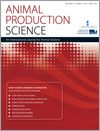
Animal Production Science
Volume 53 Number 9 2013
Dairy Science: Research & Innovation
AN12304Use of molecular technologies for the advancement of animal breeding: genomic selection in dairy cattle populations in Australia, Ireland and New Zealand
Dairy cattle breeding has been revolutionised in the last 2–4 years through the utilisation of genomic information. Utilising experiences from New Zealand, Australia and Ireland the benefits of genomic technologies are shown to be less than that expected. With on-going research it is expected that the accuracy of genomic predictions will improve and thus deliver the improved rate of genetic gain.
AN12369The symbiotic rumen microbiome and cattle performance: a brief review
The rumen microorganisms provide energy for the ruminant animal but also influence productivity, methane emissions and nitrogen retention. This review focuses on technology changes within rumen ecology, with emphasis on our research toward increased productivity of cattle. Exploring the symbiotic relationships of the rumen through (meta)genomics may hold the key to a better understanding, and subsequent improvements in productivity, with less environmental impacts.
AN12281Dairying in the Antipodes: recent past, near prospects
Australian and New Zealand dairy farm businesses are world class, but there is no guarantee that their comparative advantage over alternative land uses will continue. An analysis of key physical and financial characteristics of dairy farming shows that there is wide variation in financial performance for farm businesses no matter what level of feed inputs are used. The best performers in both countries are poised to take advantage of the increased global demand for milk products.
AN12287Performance, return and risk of different dairy systems in Australia and New Zealand
A need to remain profitable under fluctuating operating and climatic conditions has increased the intensity of dairy systems in Australia and New Zealand. This paper examined if farm technical performance, profit and risk were related to farm system intensity and complexity. Single technical performance measures were poor guides of profit, with profitable businesses being more about the skills of the farm operator, and less about the system being run.
AN12330Precision dairy farming in Australasia: adoption, risks and opportunities
Larger dairy herds, increasingly complex farming systems, and the availability of new information technologies are driving evolution of a data-driven ‘precision dairy’ management approach in Australia and New Zealand. A trans-Tasman workshop group identified primary areas to take advantage of the emerging precision dairy opportunity. A coordinated and co-operative approach involving farmers, technology developers and industry leadership is required.
AN12347The evolving extension environment: implications for dairy scientists
New thinking about the role of extension in supporting evolving dairy farm systems is required. This paper identifies significant changes and challenges impacting on the development of extension strategies in Australia and New Zealand. With increasing demand for a responsive research, development, extension and education system and declining resources, there is an imperative for dairy scientists to be active partners in addressing the challenges.
AN12276Dairy cow welfare: the role of research and development in addressing increasing scrutiny
Pasture-based dairying in New Zealand and Australia is coming under increasing animal welfare scrutiny as farms become larger and more intensive. Over the past decade, animal welfare research has helped identify the risks for animal welfare in these dairy systems, and management opportunities for ensuring good welfare. Continued research, extension and industry adoption will enable dairy producers to address changing community expectations.
AN12344Functional welfare – using biochemical and molecular technologies to understand better the welfare state of peripartal dairy cattle
Adaptations in metabolism and immune function around parturition are important determinants of dairy cattle functional capacity. Those adaptations are affected by management, nutrition, and their interactions. Through the application of metabolomics and transcriptomics technologies there is potential for developing objective indexes of the functional welfare state of peripartal dairy cattle.
AN12267Reproductive technologies for the future: a role for epigenetics
The majority of pregnancy loss in dairy cattle occurs in the first 3 weeks of pregnancy. During this time, maternal response to the embryo is a critical factor for pregnancy maintenance. This review outlines the potential regulation of pregnancy response through epigenetic mechanisms. Preliminary results from our laboratory provide support for a role of DNA methylation in regulating endometrial gene expression in response to the embryo. Understanding the environmental and nutritional regulation of DNA methylation may contribute to improved reproductive technologies in dairy cattle.
AN12384Amelioration of thermal stress impacts in dairy cows
Heat stress reduces animal performance and welfare and the severity of heat stress events will intensify according to climate predictions. This paper introduces a tool that allows dairy farmers to predict heat loads in their herd as well as provide nutritional strategies that can be implemented when heat occurs. These strategies will improve animal resilience and welfare through reducing the impact of heat stress.
AN12282Complementary forages – integration at a whole-farm level
This paper reviews the most recent dairy systems research into complementary forages. In environments which are most favourable to perennial ryegrass pasture production there is little evidence for major improvements in farm profits when moving away from this pasture based dairy system. However, complementary forages do have the potential to advance the dairy industry particularly in dairy regions with limited land and water availability.
AN12286Behaviour, illness and management during the periparturient period in dairy cows
Changes in animal behaviour can be used for the early identification of sick animals. The period around parturition is a time when dairy cattle are at the greatest risk of disease; monitoring behaviour during this time may help improve herd health and promote good management practices.
AN12293Nutritional management of the transition cow in the 21st century – a paradigm shift in thinking
The transition from pregnancy to lactation is the most metabolically traumatic period of a cow’s lactation. Failure to transition successfully results in an increased risk of metabolic and infectious disease, low productivity and decreased longevity. Nutrition strategies to maximise the chances of a successful transition are discussed.



